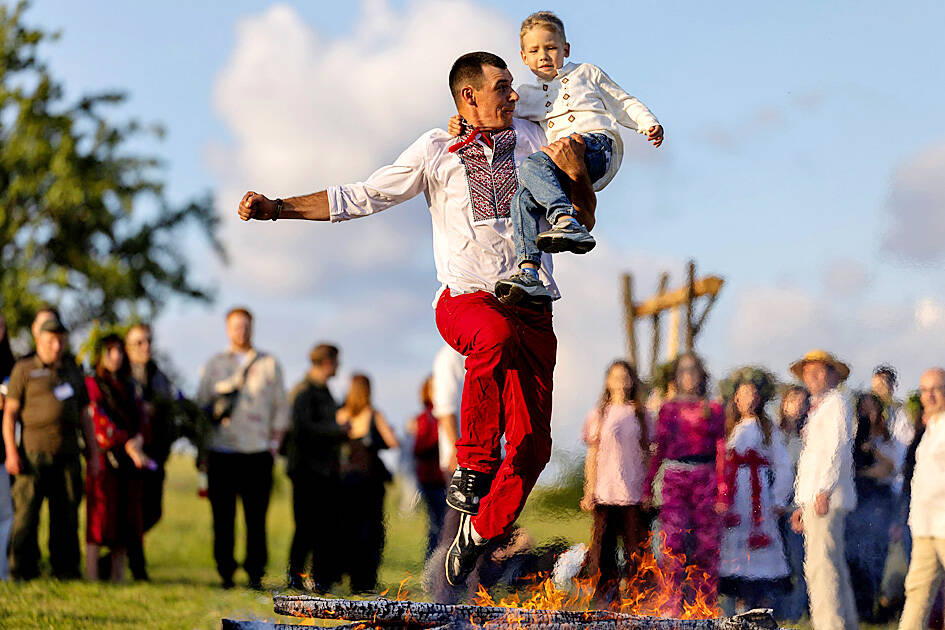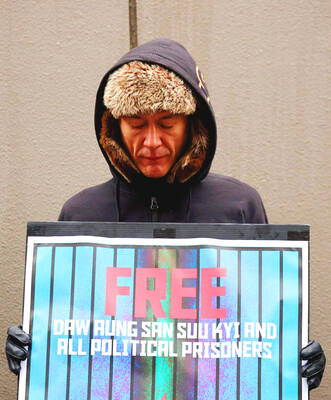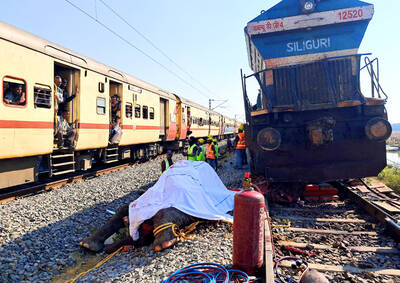Hundreds of Ukrainians observed the longest day of the year on Saturday with a midsummer celebration of some of their oldest traditions, a display of cultural perseverance in a nation threatened by war.
Rooted in Ukraine’s ancient past of Slavic paganism the event, Ivana Kupala, features rituals and symbolism to honor the summer solstice, related to fertility, nature, purity and renewal — values that predate the region’s Christianization at the end of the first millennium.
At the open-air National Museum of Folk Architecture and Ukrainian Life on the outskirts of Kyiv, participants in embroidered shirts and blouses strolled among thatched-roof cottages, wooden churches and windmills dating to the 18th and 19th centuries. Women and girls wore vinoks — wreaths made from wildflowers — as they took part in folk dances, games and craft workshops.

Photo: REUTERS
Viktoria Phi, a master of folk art at the museum, taught visitors to weave the colorful flowered headdresses.
Ivana Kupala, which also has variations in other Slavic countries from the Czech Republic to Bulgaria to Russia, was a “small oasis” in the war in Ukraine, where people can “walk and enjoy nature, architecture, songs and dances,” she said.
“It’s most popular among young people, and I am very happy when a family comes with young children,” she said.
As the sun began to set over the wheat fields and wildflower meadows, hundreds formed a circle around a pyramid of logs. When the bonfire was lit, flames climbed into the twilight sky as music swelled and people spun around the pyre hand in hand. In a purification rite, some leapt over the burning embers.
With Russia’s war in Ukraine now in its fourth year and aerial attacks on cities intensifying, for some the observance of old folk customs holds deeper meaning.
Saba Alekseev, 25, said the event gave her a chance to “breathe some fresh air without thinking about [the war], for some time at least, because it’s impossible to put it out of your mind under shelling.”
For 18-year-old Sofia Orel, it was a reminder that “it is crucial to support Ukrainian culture and traditions, especially since the war started, because this way we preserve what is ours.”
“As I am weaving a wreath, I’m thinking that I will teach my daughter how to do it,” she said. “These are our traditions and they have to be passed on and honored.”

The Burmese junta has said that detained former leader Aung San Suu Kyi is “in good health,” a day after her son said he has received little information about the 80-year-old’s condition and fears she could die without him knowing. In an interview in Tokyo earlier this week, Kim Aris said he had not heard from his mother in years and believes she is being held incommunicado in the capital, Naypyidaw. Aung San Suu Kyi, a Nobel Peace Prize laureate, was detained after a 2021 military coup that ousted her elected civilian government and sparked a civil war. She is serving a

REVENGE: Trump said he had the support of the Syrian government for the strikes, which took place in response to an Islamic State attack on US soldiers last week The US launched large-scale airstrikes on more than 70 targets across Syria, the Pentagon said on Friday, fulfilling US President Donald Trump’s vow to strike back after the killing of two US soldiers. “This is not the beginning of a war — it is a declaration of vengeance,” US Secretary of Defense Pete Hegseth wrote on social media. “Today, we hunted and we killed our enemies. Lots of them. And we will continue.” The US Central Command said that fighter jets, attack helicopters and artillery targeted ISIS infrastructure and weapon sites. “All terrorists who are evil enough to attack Americans are hereby warned

Seven wild Asiatic elephants were killed and a calf was injured when a high-speed passenger train collided with a herd crossing the tracks in India’s northeastern state of Assam early yesterday, local authorities said. The train driver spotted the herd of about 100 elephants and used the emergency brakes, but the train still hit some of the animals, Indian Railways spokesman Kapinjal Kishore Sharma told reporters. Five train coaches and the engine derailed following the impact, but there were no human casualties, Sharma said. Veterinarians carried out autopsies on the dead elephants, which were to be buried later in the day. The accident site

‘NO AMNESTY’: Tens of thousands of people joined the rally against a bill that would slash the former president’s prison term; President Lula has said he would veto the bill Tens of thousands of Brazilians on Sunday demonstrated against a bill that advanced in Congress this week that would reduce the time former president Jair Bolsonaro spends behind bars following his sentence of more than 27 years for attempting a coup. Protests took place in the capital, Brasilia, and in other major cities across the nation, including Sao Paulo, Florianopolis, Salvador and Recife. On Copacabana’s boardwalk in Rio de Janeiro, crowds composed of left-wing voters chanted “No amnesty” and “Out with Hugo Motta,” a reference to the speaker of the lower house, which approved the bill on Wednesday last week. It is